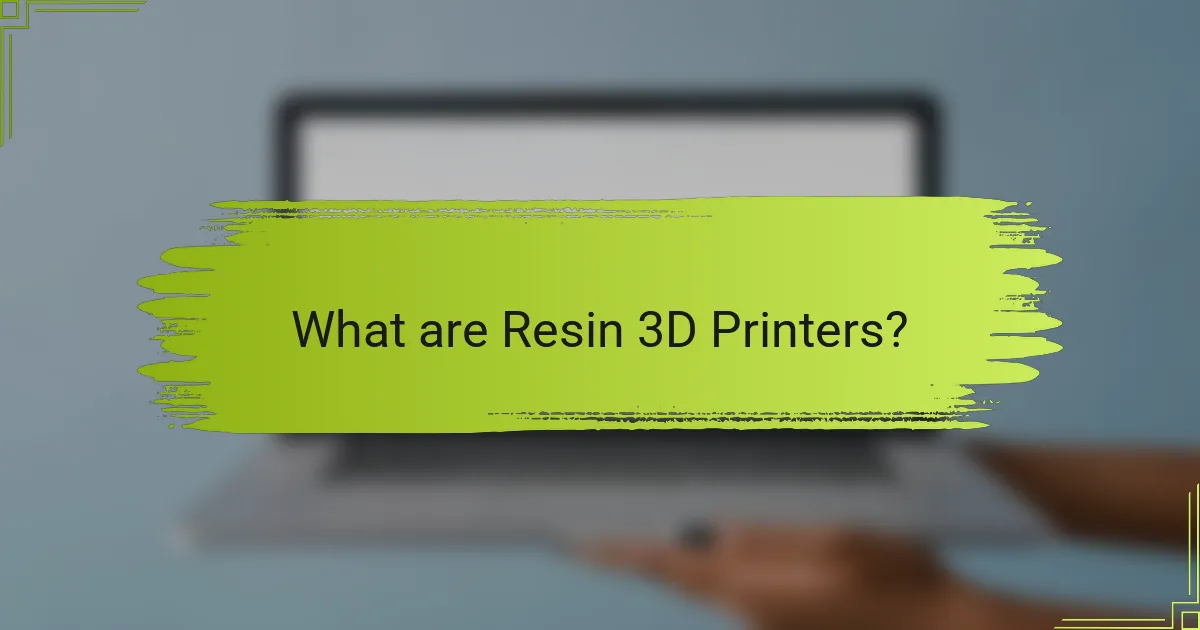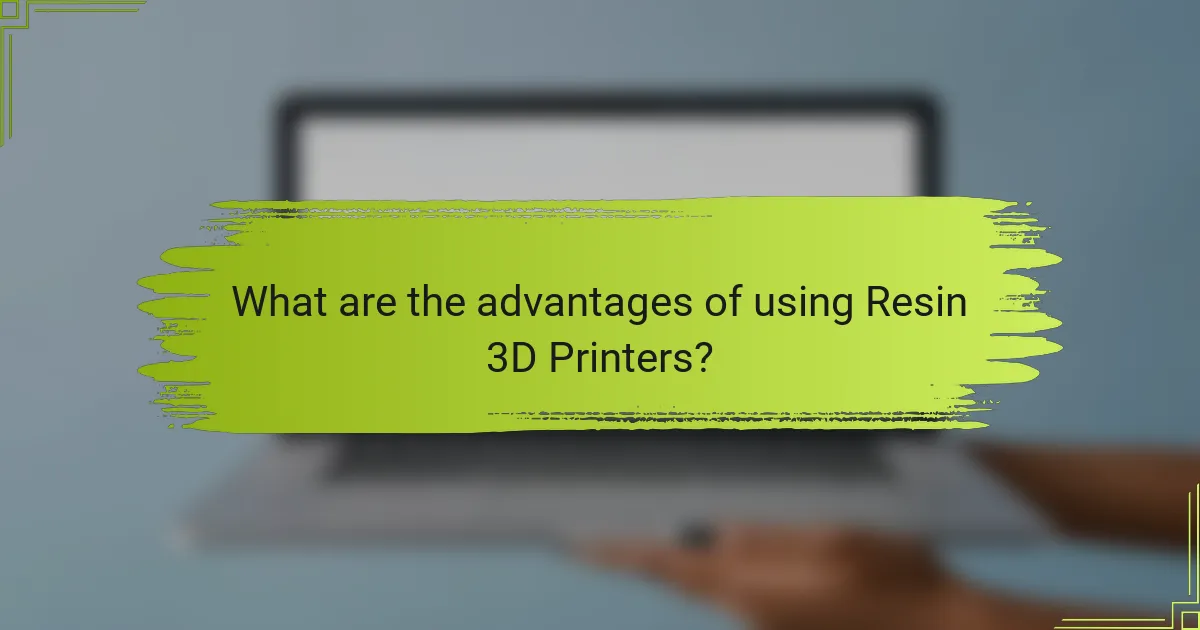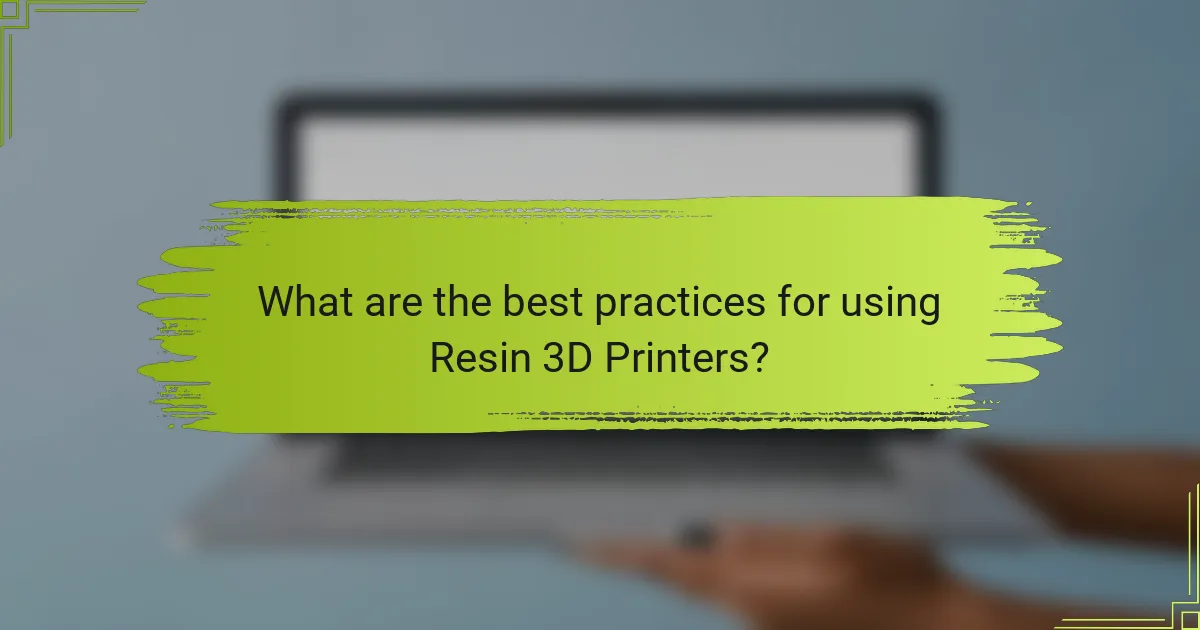
What are Resin 3D Printers?
Resin 3D printers are devices that create three-dimensional objects using liquid resin. They utilize a process called stereolithography (SLA) or digital light processing (DLP). In this process, a light source cures the resin layer by layer. The light solidifies the resin in specific patterns to form the desired shape. This technology allows for high precision and detail in printed objects. Resin 3D printers are commonly used in industries such as jewelry, dental, and prototyping. Their ability to produce intricate designs makes them popular among hobbyists and professionals alike.
How do Resin 3D Printers differ from other types of 3D printers?
Resin 3D printers differ from other types of 3D printers primarily in their printing technology. They use a process called stereolithography or digital light processing. This involves curing liquid resin layer by layer using UV light. Other 3D printers, like FDM printers, extrude thermoplastic filament to create objects. Resin printers typically offer higher resolution and finer details. They produce smoother surfaces compared to filament-based printers. However, resin printing can be more complex and requires post-processing. The materials used in resin printing are often more expensive than those for FDM printing.
What is the technology behind Resin 3D printing?
Resin 3D printing technology primarily employs photopolymerization. This process involves using light to cure liquid resin into solid objects. The printer projects UV light onto the resin, causing it to harden layer by layer. Common methods include Stereolithography (SLA) and Digital Light Processing (DLP). SLA uses a laser to trace each layer, while DLP employs a digital light projector for faster curing. Both methods create high-resolution prints with intricate details. The technology has advanced significantly, allowing for a variety of resin types, including flexible and durable options. This versatility makes resin 3D printing suitable for applications in prototyping, jewelry, and dental industries.
What materials are used in Resin 3D printing?
Resin 3D printing primarily uses photopolymer resins. These resins are liquid substances that harden when exposed to specific wavelengths of light. Common types of resins include standard resin, tough resin, flexible resin, and castable resin. Standard resin is used for general-purpose printing. Tough resin offers enhanced durability and impact resistance. Flexible resin allows for the creation of bendable parts. Castable resin is designed for jewelry and dental applications, enabling easy burnout during casting. Each resin type has unique properties suited for different applications in 3D printing.
What are the key features of Resin 3D Printers?
Resin 3D printers are known for their high precision and detail in printing. They utilize liquid resin that is cured layer by layer using UV light. This process allows for intricate designs and smooth surface finishes. Resin printers generally have faster print speeds compared to FDM printers. They also produce less visible layer lines, resulting in a more polished final product. Many resin printers feature a build platform that is adjustable for better adhesion and leveling. Additionally, they often include a resin tank that is easy to replace and clean. These printers are popular in industries such as jewelry, dental, and prototyping due to their accuracy and versatility.
How do build size and resolution impact the printing process?
Build size and resolution significantly influence the printing process in resin 3D printers. A larger build size allows for the creation of bigger objects in a single print. However, this can lead to longer print times and increased material consumption. Higher resolution results in finer details and smoother surfaces. It enhances the overall quality of the printed object. Yet, higher resolution typically requires longer curing times, which can extend the total printing duration. Balancing build size and resolution is crucial for optimizing print quality and efficiency. For instance, a study by Wohlers Associates highlights that larger prints often exhibit more warping and detail loss if not managed properly.
What are the common types of resin used in these printers?
Common types of resin used in 3D printers include standard resin, tough resin, flexible resin, and castable resin. Standard resin is widely used for general-purpose printing. It provides good detail and surface finish. Tough resin is designed for durability and impact resistance. Flexible resin allows for bending and stretching. Castable resin is used for creating molds and jewelry. Each type serves specific applications in 3D printing.

What are the advantages of using Resin 3D Printers?
Resin 3D printers offer high precision and detail in printing. They can produce intricate designs that are often difficult for filament printers to achieve. The layer resolution of resin printers typically ranges from 25 to 100 microns, allowing for smoother surfaces. This high resolution makes them ideal for applications like jewelry, dental models, and miniatures. Additionally, resin printers can create complex geometries with ease due to their ability to print in multiple orientations. Fast print speeds are another advantage, with some models capable of printing entire layers in seconds. The variety of available resins allows for diverse material properties, including flexibility and durability. Overall, the advantages of resin 3D printers make them suitable for specialized applications requiring precision and quality.
Why choose Resin 3D printing over FDM printing?
Resin 3D printing is often chosen over FDM printing for its superior detail and surface finish. Resin printers can achieve layer resolutions as fine as 25 microns. This allows for intricate designs and smooth surfaces that FDM printers struggle to replicate. Additionally, resin printing typically results in stronger and more durable parts compared to FDM. The materials used in resin printing, like photopolymer resins, often have enhanced mechanical properties. This makes them suitable for functional prototypes and end-use parts. Furthermore, resin printers generally have faster print speeds for small to medium-sized objects. These factors make resin 3D printing a preferred choice for applications requiring high precision and quality.
What are the benefits of high-resolution prints?
High-resolution prints provide superior detail and clarity compared to lower-resolution options. They capture intricate designs and fine features effectively. This level of detail is crucial for applications like prototyping and art. High-resolution prints enhance the overall visual appeal of the final product. They also improve the accuracy of models and prototypes, which is essential in engineering and design. Additionally, high-resolution prints reduce the need for post-processing, saving time and resources. Studies show that higher resolution can lead to better user satisfaction and perceived quality. Overall, high-resolution prints offer significant advantages in precision, aesthetics, and efficiency.
How does the speed of printing compare to other methods?
The speed of printing with resin 3D printers is generally faster than traditional FDM (Fused Deposition Modeling) methods. Resin printers can produce a layer in seconds, while FDM printers typically take minutes per layer. For example, a resin printer can achieve speeds of 30 to 50 mm per hour, compared to FDM speeds of 10 to 20 mm per hour. This efficiency is due to the continuous layer curing process in resin printing. Additionally, resin printers can create intricate details in less time than FDM printers. Thus, resin printing is often preferred for rapid prototyping and detailed models.
What industries benefit from Resin 3D printing?
Resin 3D printing benefits several industries including healthcare, aerospace, automotive, and jewelry. In healthcare, it is used for creating precise dental models and surgical guides. Aerospace utilizes resin printing for producing lightweight and complex parts. The automotive industry employs it for prototyping and tooling applications. Jewelry makers benefit from the high detail and finish that resin printing provides for intricate designs. Each of these industries values the accuracy and quality that resin 3D printing delivers.
How is Resin 3D printing utilized in prototyping?
Resin 3D printing is utilized in prototyping to create highly detailed and accurate models. This technology allows for rapid production of prototypes with intricate designs. The layer-by-layer process ensures fine resolution, making it ideal for complex geometries. Prototypes can be produced quickly, often within hours, which accelerates the design iteration process. Additionally, resin 3D printing supports various materials that can mimic the properties of final products. This includes flexibility, durability, and heat resistance. As a result, companies can test functionality and aesthetics before mass production. Overall, resin 3D printing enhances the prototyping phase by providing speed and precision.
What role does Resin 3D printing play in jewelry design?
Resin 3D printing plays a crucial role in jewelry design by enabling the creation of highly detailed and intricate pieces. This technology allows designers to produce complex geometries that traditional methods struggle to achieve. The precision of resin printing results in smooth surfaces and fine details, enhancing the overall aesthetic of the jewelry. Additionally, it offers rapid prototyping capabilities, allowing designers to quickly iterate on their designs. According to a study published in the Journal of Manufacturing Processes, resin 3D printing can reduce production time by up to 75%. This efficiency is vital in the fast-paced jewelry market. Overall, resin 3D printing significantly enhances creativity and production efficiency in jewelry design.

What are the best practices for using Resin 3D Printers?
The best practices for using resin 3D printers include proper ventilation and safety precautions. Users should always work in a well-ventilated area to avoid inhaling fumes. Wearing gloves and safety goggles protects against skin contact and eye exposure. Calibration of the printer is essential for achieving accurate prints. Regularly checking the resin level ensures consistent printing quality. Cleaning the build plate and resin vat after each print prevents contamination. Using the correct exposure time for different resins enhances print fidelity. Finally, following the manufacturer’s guidelines ensures optimal printer performance. These practices help achieve high-quality prints and maintain safety during the printing process.
How can users ensure optimal print quality?
Users can ensure optimal print quality by selecting the right resin and printer settings. Choosing high-quality resin improves detail and finish. Adjusting layer height affects the resolution; lower heights yield finer details. Correct exposure time is crucial; too short results in incomplete curing, while too long leads to overexposure. Maintaining a clean printer environment prevents dust and debris from affecting prints. Regularly calibrating the printer ensures consistent performance. Using a well-designed support structure minimizes print failures. Following manufacturer guidelines for settings enhances overall print quality.
What settings should be adjusted for different resin types?
Different resin types require specific adjustments in settings for optimal printing. For standard resins, exposure time typically ranges from 8 to 15 seconds per layer. This setting ensures proper curing without overexposure. For flexible resins, exposure time may decrease to 5 to 10 seconds to maintain elasticity.
The layer height also varies; standard resins often use 0.05 to 0.1 mm, while flexible resins can use thicker layers for faster prints. Temperature settings should be monitored, as some resins perform better at warmer conditions, around 25 to 30 degrees Celsius.
Print speed can also be adjusted; for high-detail resins, a slower speed is preferred, while faster speeds can be used for draft prints. These adjustments ensure quality and performance tailored to each resin type.
How important is post-processing in Resin printing?
Post-processing is crucial in resin printing. It significantly enhances the quality and accuracy of 3D printed models. After printing, models often require cleaning to remove uncured resin. This step is essential to prevent damage and improve surface finish. Additionally, post-curing under UV light solidifies the resin further, increasing strength and durability. Research indicates that proper post-processing can reduce the risk of print failure by up to 30%. Overall, neglecting post-processing can lead to inferior results and compromised structural integrity.
What safety measures should be taken when using Resin 3D Printers?
When using Resin 3D Printers, proper safety measures are essential to prevent health risks. Always operate the printer in a well-ventilated area. This minimizes exposure to harmful fumes released during printing. Wear appropriate personal protective equipment (PPE), including gloves and safety goggles. These protect the skin and eyes from resin exposure. Use a mask designed for organic vapors to avoid inhaling harmful particles. Ensure that all materials, including resin and cleaning agents, are stored safely and out of reach of children and pets. Follow the manufacturer’s guidelines for handling and disposing of resin. This ensures compliance with safety regulations and reduces environmental impact. Always keep a fire extinguisher nearby, as some resins can be flammable. Regularly inspect the printer for leaks or malfunctions to maintain a safe working environment.
What personal protective equipment is recommended?
Recommended personal protective equipment (PPE) for resin 3D printing includes gloves, goggles, and masks. Gloves protect the skin from harmful chemicals present in resin. Goggles shield the eyes from splashes and harmful UV light. Masks prevent inhalation of fumes and particles during printing and post-processing. Using this PPE minimizes health risks associated with resin exposure. Proper use of PPE is supported by safety guidelines from organizations like OSHA, emphasizing the importance of protection in hazardous environments.
How should resin waste be handled and disposed of?
Resin waste should be handled and disposed of according to local regulations and safety guidelines. First, ensure that resin waste is collected in a designated container that is compatible with the material. Use gloves and protective gear to prevent skin contact. Dispose of uncured resin waste as hazardous waste at a designated facility. Cured resin waste can typically be disposed of in regular trash, but confirm with local waste management. Always follow Material Safety Data Sheets (MSDS) for specific disposal instructions. Proper handling minimizes environmental impact and health risks.
What troubleshooting tips can help improve results with Resin 3D Printers?
Calibrate the printer regularly to ensure accurate layer alignment. Check the resin vat for proper leveling before starting prints. Use the correct exposure settings based on the resin type to enhance curing. Maintain a clean build plate to promote adhesion and prevent failures. Inspect the UV light source for consistent intensity and replace if necessary. Monitor the ambient temperature and humidity as they can affect print quality. Ensure proper ventilation to prevent resin fumes from affecting the print environment. Regularly update printer firmware to benefit from improvements and fixes.
Resin 3D printers are advanced devices that create three-dimensional objects using liquid resin through processes like stereolithography (SLA) and digital light processing (DLP). This article outlines the key features, advantages, and materials associated with resin 3D printing, highlighting its high precision, detail, and suitability for various industries such as healthcare, jewelry, and prototyping. Additionally, it covers best practices for optimal use, including safety measures, post-processing techniques, and troubleshooting tips to enhance print quality. The comprehensive overview aims to provide essential insights into the functionality and application of resin 3D printers.